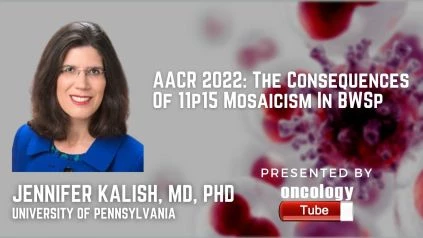Jennifer M. Kalish, MD, Ph.D., Assistant Professor of Pediatrics, Research Scientist, Director, Beckwith-Wiedemann Syndrome Clinic, at Children’s Hospital of Philadelphia. In this video, she speaks about the AACR 2022 abstract – 5220 – The consequences of 11p15 mosaicism in Beckwith-Wiedemann syndrome/spectrum: Epigenotypes associated with cancer development and necessity for universal tumor screening.
Â
Â
Beckwith-Wiedemann Spectrum Condition (BWSp) is the most prevalent (epi)genetic cancer predisposition disorder. BWSp has a variable clinical course and is caused by epigenetic alterations at two locations on chromosome 11p15. These epigenetic alterations take place post-zygotically, resulting in a patchwork distribution across tissues. Clinical molecular testing often begins with blood; however, we and others have shown that testing on damaged tissues increases the rate of positive molecular testing. Patients with BWS are at risk of developing embryonal cancers (Wilms tumor (WT), hepatoblastoma (HB), and neuroendocrine tumors), hence clinical and molecular diagnosis is critical. Formal surveillance guidelines were released in 2017 as part of a cancer predisposition effort in the United States, recommending alpha fetoprotein and full abdominal ultrasound monitoring for all patients with BWSp until the age of four for HB and seven years for WT. In contrast, the BWS international consensus group (BWS-ICG), located in Europe, used stratified cancer screening guidelines based on (epi)genotype. We evaluated cancer development rates and epigenotype profiles related with cancer in BWSp patients in this study. We present a series of patients with a history of WT, HB, and/or neuroendocrine tumors to demonstrate that BWSp epigenotype profiles can differ in tumor and adjacent normal tissue compared to blood, demonstrating the presence of multiple cell populations with distinct epigenetic changes within patients. These different modifications demonstrate that several epigenetic changes in the chromosome 11p15 region can exist in a single tissue type. These findings imply that using epigenetic classification in blood alone to stratify cancer risk in BWSp is not a good idea. Furthermore, the moderate BWSp clinical phenotype and low BWS-ICG clinical scores for these individuals indicate that some patients have minimal external features. As a result, neither blood epigenotype nor external phenotype can assist predict an individual’s tumor risk. This study also implies that the BWS-ICG tumor risk assessment system cannot be extended to the entire Beckwith-Wiedemann Spectrum due to the evolving epigenetic and phenotypic landscape of BWSp patients. These findings support the notion that all individuals with even minor BWSp symptoms and/or an 11p15 epigenetic mutation undergo universal tumor screening.

